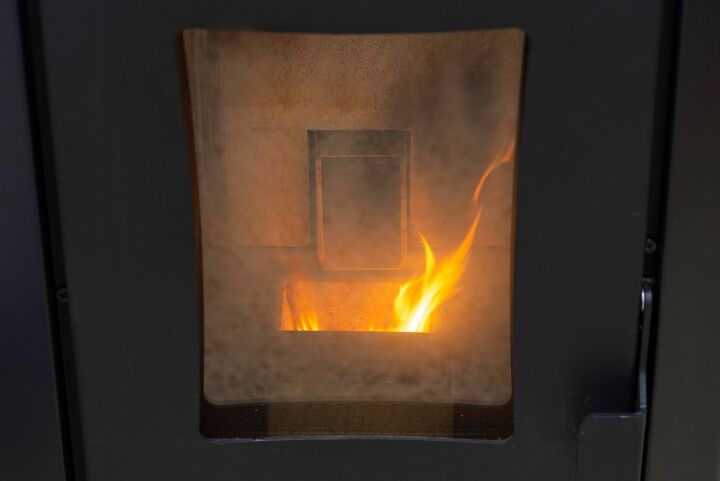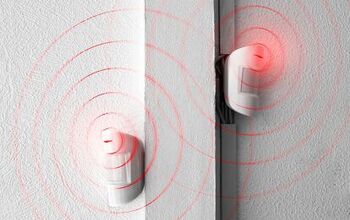Why Does My Pellet Stove Keep Shutting Off?

Pellet stoves are a great way to heat your home. They are efficient and economical. However, when they malfunction or keep shutting off, it can be frustrating. Each separate component of the stove’s construction has to work efficiently for the unit to function as it should.
When your pellet stove keeps shutting off, there are many possible reasons. These include but are not limited to:
- Faulty wiring in the stove
- Combustion Air Damper
- Combustion Blower
- The air switch
- Something wrong with the airflow
This article will dive into the six most common reasons your pellet stove might keep shutting off. Also, we explain how a pellet stove works so you can better understand the intricacy of your heating source.
Do You Need Stove Repair Services?
Get free, zero-commitment quotes from pro contractors near you.

How Do Pellet Stoves Work?
Pellet stoves look remarkably similar to wood-burning stoves, but they work quite differently. However, they are simple to operate. To understand what could go wrong, you first need to understand how they work.
- Pellets are poured into a storage hopper at the top of the stove.
- When more is needed, the sensors instruct the auger (a tool which resembles a corkscrew) to send pellets from the hopper into the burn chamber.
- The number of pellets will always be the minimum required to keep the flame small but exceedingly hot.
- Pellet stoves have two blowers:
A combustion blower sucks air into the stove through an air vent and discharges smoke through an exhaust vent.A convection blower pulls air into the stove and emits the hot air via several heat-exchangers.
The heat from the pellet stove is delivered according to the settings on the thermostat setting. Having a good amount of airflow, the only thing you should have to do is load more pellets when necessary.
Mechanisms Of A Pellet Stove
Mechanism | Function |
Pellets | Energy-dense hardwood and softwood sawdust extrusions |
Auger | A corkscrew-like mechanism that moves wood pellets from the hopper to the fuel chute. |
Fuel Chute | Moves the pellets from the hopper into the firepot. |
Igniter | Starts the pellets burning electrically, no matches needed. |
Fire Pot | Holds about a handful of burning pellets. It’s set against a refractory firewall and cast-iron floor. |
Warm Air Blower | Circulates air from the room through the heat exchanger and sends it back into the room. |
Hopper | Wood pellets are stored in this. |
Reasons Your Pellet Stove Keeps Shutting Off
While more recent models will display the reason for a shut-off on the unit, that’s not always the case. When the stove shuts off, the most common cause is that the unit is dirty or that there isn’t enough heat to trip the sensors.
Another reason your pellet stove keeps shutting off is that a faulty or worn-down area prevents the pellets from feeding into the auger correctly. However, there are several other reasons. Here are six of the most common:
- Stove Wiring
- Combustion Air Damper
- Combustion Blower
- Burn Pot
- Combustion Air Tube
- Air Flow
Basic DIY Instructions By Part
Stove Wiring
Step 1: Check Switches and Circuit Breaker
Sometimes the outlet voltage doesn’t reach certain limits, which causes your stove not to perform correctly. You need to measure the power that is supplied from the outlet. Check the switches and circuit breaker to make sure nothing is keeping power from the stove.
Step 2: Voltage Readings
Check the terminal for any wires that may be loose or disconnected. Use a multimeter set to AC voltage so you can read the power from the terminal strip. Your voltage should read 120 volts for all the terminals.
Step 3: Check Your Wires
Look at the stove wiring that connects to each of these sections of your stove:
- Low Limit Thermodisc
- High Limit Thermodisc
- Combustion Blower
- Convection Blower
- Auger Motor
- Igniter
Look for any cracked or frayed wires. Inspect all of the connections to ensure they are secure and working correctly. If you find that there are, you will need to replace those particular wires. You can take them to a home improvement store to match them up to the correct wire.
Combustion Air Damper
The job of your combustion air damper is to limit the air that’s available to the fire. This allows you to adjust the air to fuel ration to burn your pellets at a desirable rate.
Step 1: Adjust Your Damper
Try adjusting your damper to resolve your issues. If your pellets are burning at a low feeding rate, this can cause your pellet stove to shut off, and it causes the soot to build up. Close your damper fully and then open it by ¼”.
Step 2: Open Your Damper According To Speed
For each setting above low, your damper should be opened by ¼”. For instance, if the medium is three levels above low, you will need to open your damper by ¾”. If your air damper is the issue, this will resolve it relatively quickly.
Combustion Blower
If your combustion blower is spinning too slow, it will decrease the airflow in the firebox. Decreased airflow in the firebox will keep the air switch from sensing the correct level of vacuum. In this case, you will need to remove the combustion blower from the stove and perform a bench test.
Your impeller should spin at a high-speed rate. If this doesn’t happen, the motor may be sluggish. If your motor isn’t working how it should, then you will need to replace the motor.
Burn Pot
If your burn pot isn’t mounted correctly, or if it’s causing obstructions, this can be an issue.
Step 1: Check The Position
You need to check and see if your burn pot fits appropriately over the combustion air tube. Your burn pot needs to be mounted about 1/8” away from the wall of the firebox. If this isn’t correctly positioned, the air will not move through enough for your stove to operate the correct way.
Step 2: Look For Obstructions
Check for any obstructions that might be restricting airflow. Ash and clinkers can fall through some of the ports for drawing air. You can use an air compressor to blow it clear. If you don’t have one, shaking it will help to clear it up. Make sure you pay attention to the narrow bottom.
Before you reinstall your burn pot, you need to remove the combustion air supply duct. This is connected to the inlet of the combustion air tube. Use a mirror and a flashlight to check for obstructions in this as well.
Combustion Air Tube
There cannot be any obstructions in the combustion air tube if the stove receives enough combustion air to operate correctly. If you have an older model and uses a coupling to join the damper blade and control rod, you may be misusing it, and it may have come loose.
Step 1: Remove Damper
Pull the damper out and check to see that the blade clears the inside of the tube. Also, look for anything that might be restricting the airflow through the combustion air tube.
Step 2: Check Wires
Check that all the wiring is connected correctly. Improper wiring will cause significant issues, including the random shut off of your pellet stove. While you’re at it, look for cracks and obstructions in the air tube.
Air Flow
If you do not have an outside air supply coming into your stove, it will draw air through the grilles on the side of your stove or the fireplace cover. If the air inlet is inhibited, the flame will create excess smoke even if your damper is all the way open.
Step 1: Inspect Grilles For Blockages
Open your grilles on the sides of your stove to look for blockages. If you see that there is a significant amount of soot, clean them up. Although cleaning them may be a good idea anyway, since you’re already there.
Step 2: If Your Stove Sits Inside A Fireplace
If your stove is inside a fireplace, you should move it out about ½,” and it should improve the airflow. Try this out, and if it helps your stove burn better, consider installing a combustion air supply duct. It should go directly through your chimney or the fireplace’s back wall.
Related Questions
How do I reset my pellet stove?
If your stove doesn’t have a reset button, you can reset by just allowing it to run out of pellets. Without pellets, it can no longer heat, so it is effectively reset.
How high should the flame be on a pellet stove?
The ideal flame is yellow and steady, not flickering or moving side to side. It has to be hot, but not too intensely hot. It means that the stove is burning cleanly and efficiently.
Do You Need Stove Repair Services?
Get free, zero-commitment quotes from pro contractors near you.

Our Takeaway
While many different issues could cause your pellet stove to keep turning off, the ways to fix them are pretty straightforward. If you walk through every circumstance but cannot correct it, it may be time to hire a professional for diagnosis. This will provide a general direction for you to go about fixing the heating source for your home.

Heather is a passionate writer who loves anything DIY. Growing up, she learned everything from home repairs to design, and wants to share her tips with you. When she's not writing, she's usually hiking or searching for her next DIY project.
More by Heather Robbins











![The 5 Best Angle Grinders – [2022 Reviews & Buyer's Guide]](https://cdn-fastly.upgradedhome.com/media/2023/07/31/9071326/the-5-best-angle-grinders-2022-reviews-buyer-s-guide.jpg?size=350x220)















